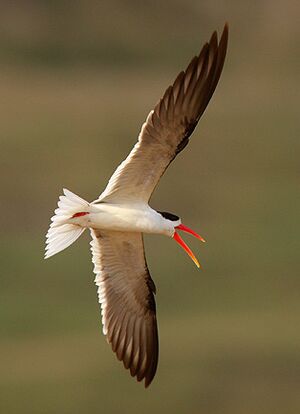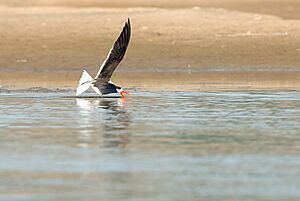Indian skimmer facts for kids
Quick facts for kids Indian skimmer |
|
|---|---|
 |
|
| Conservation status | |
| Scientific classification | |
| Genus: |
Rynchops
|
| Species: |
albicollis
|
| Synonyms | |
|
Rhynchops albicollis |
|
The Indian skimmer (Rynchops albicollis) is a special type of bird. It's one of three species in the skimmer family. These birds look a bit like terns. But they have a very unique bill! The top part of their bill is shorter than the bottom part. They use this bill to "skim" the water. They fly low and scoop up fish and other small water creatures.
You can find Indian skimmers in southern Asia. Their numbers are going down, so they are becoming rare. They mostly live near rivers or in places where rivers meet the sea. Their bright black, white, and orange colors make them easy to spot.
Contents
About the Indian Skimmer
This bird has a black cap on its head. Its bill is bright orange. The rest of its body is white. Indian skimmers have long wings. They look a lot like terns when they fly. These birds are about 40 to 43 centimeters (16-17 inches) long. Their wings can spread out to about 108 centimeters (42 inches).
Their upper body is dark black. Their belly and chest are white. The black cap on their head leaves their forehead and the back of their neck white. Their wings are long and pointed. They have a white edge at the back. Their tail is short and forked. It is white with some black feathers in the middle.
Their Special Bill
The Indian skimmer's bill is very unique. It is long and thick. It is orange with a yellow tip. The lower part of the bill is longer than the upper part. This lower part is thin and sharp, like a knife. It is also flexible. Young skimmers have bills that look more normal. As they grow older, the lower part of their bill gets longer. The upper part of the bill can move a lot. This helps them catch food.
Young Skimmers and Their Calls
Adult birds that are not breeding look a bit duller. They are more brownish. Young skimmers are grey-brown on top. Their feathers have pale edges. Their heads have more white than adult birds. Their bill is orange-brown with a dark tip.
Indian skimmers usually don't make much noise. But they do have a loud, high-pitched call. It sounds like kyap-kyap.
Skimmer Cousins
There are other skimmer birds in the world. The black skimmer lives in the Americas. It is bigger than the Indian skimmer. Its bill has a black tip. The African skimmer is smaller. It has more black on its tail. It also does not have a white collar. In the past, the Indian skimmer was sometimes called the Indian scissors-bill.
Where Indian Skimmers Live

You can find Indian skimmers near large rivers and lakes. They also live in swamps and coastal wetlands. These include places where rivers meet the sea. They prefer fresh water, especially when they are breeding. They build their nests on islands or sandy areas. These are usually found in rivers.
Their homes have become smaller over the years. They are now found in parts of Pakistan. You can also see them in northern and central India. They live along the Ganges River. They are also in Bangladesh and Burma. They used to live in Laos, Cambodia, and Vietnam. But they are rarely seen there now.
Indian skimmers sometimes visit Nepal. They have also been seen by chance in Oman and central Thailand. In the past, there were records from Iran and China. Today, most Indian skimmers live in India and Bangladesh. In winter, they spread out more. They can be found in coastal areas of western and eastern India.
Breeding Spots
Many Indian skimmers breed in the Chambal River area. This area is also important for the gharial, a type of crocodile. Sand banks are very important for both skimmers and gharials to lay their eggs. Skimmers have also been seen breeding on the banks of the Mahanadi River in Cuttack.
How Indian Skimmers Live
How They Find Food
Indian skimmers find food by flying low over the water. They keep their bill open. The lower part of their bill skims through the water. When they hit a fish, it moves up the lower bill. The bird then quickly raises its upper bill. It snaps its head to catch the fish.
They often hunt in small groups. They might even hunt with terns. They mostly eat fish. But they also eat small crustaceans, like tiny crabs. They also eat insect larvae. They often hunt in the evening. Sometimes, they even hunt at night.
Reproduction and Nests
The breeding season for Indian skimmers is usually from March to May. They breed in groups called colonies. A colony can have up to 40 pairs of birds. They often nest with terns and other birds.
Their nest is very simple. It's just a shallow dip in the ground. They make it on open sand banks. These spots give them a clear view of any animals that might try to attack them. The eggs are buff or white. They have brown spots and lines. A female skimmer usually lays three to five eggs.
Sometimes, they might lay their eggs in the nests of river terns. This is called brood parasitism. The birds spend more time sitting on their eggs during the cooler parts of the day. They often leave the nest during the hottest hours. Adult skimmers might soak their bellies in water. Then they go back to the nest to cool down their eggs.
Protecting Indian Skimmers
The Indian skimmer used to live in many rivers. These included rivers in India, Pakistan, Myanmar, and the Mekong region. Records from Laos, Cambodia, and Vietnam are mostly from the 1800s. They are very rare there now.
Most of the Indian skimmer population is now in India and Pakistan. Experts believe there are only about 6,000 to 10,000 of these birds left. Because their numbers are dropping, they are now listed as an Endangered species. This means they are at high risk of disappearing forever.
They are in danger because their homes are being destroyed. Pollution also harms them. And humans sometimes disturb their nesting areas. Most of their colonies are not protected. But some are in special nature reserves. One example is the National Chambal Sanctuary in India.
Images for kids





